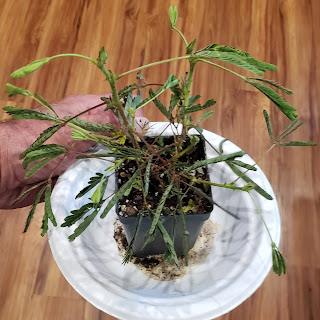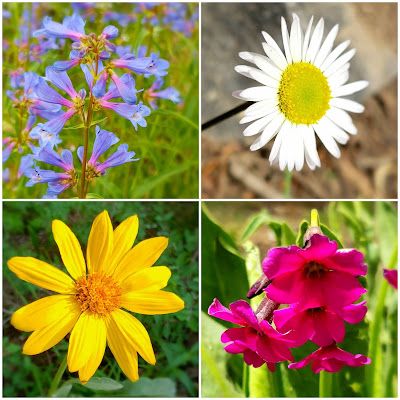Mimosa - sensitive plant
I've always been intrigued by this variety of plant, because of the unusual behavior it demonstrates. Generally we expect plants to be very slow-growing, and not to exhibit any spontaneous motion. We know some sunflowers can turn their "faces" towards the sun. Some blooms (e.g. poppies, water lillies) are open during the day but close at night. Some are the other way around, blooming at night and closing during the day (datura or moonflower, evening primrose). But the motion associated with these activities is very slow and gradual (a time-lapse video can be astonishing!). The fastest-growing plant, a variety of bamboo, can grow vertically as much as 35" per day - about 1/4" every 10 minutes, almost fast enough to be visible to the naked eye!
But this plant, the Mimosa pudica or "sensitive plant," will rapidly fold its compound, fern-like leaves inward and droop when touched or disturbed. The "purpose" is presumably to protect from harm - the leaves reopen within a few minutes. The leaves also close more gradually to "sleep" like this at night.
Faster plant motion occurs in the Venus Flytrap, which snaps its "jaws" closed on an unsuspecting insect in about a tenth of a second. Other plants exhibit even faster motion when they rapidly expel pollen or seeds in a dramatic burst.
How does the Mimosa retract its leaves? Scientists say it happens with changes in water pressure that impact the supporting plant cells and fibers.
To me, it's hard to imagine that this is an evolutionary adaptation for protection - if so, wouldn't we expect to see it in many more kinds of plants? I sometimes imagine a Creator musing, "How about we have a little fun with this one?" It is almost endlessly entertaining to watch, since it's so unusual and unexpected. (Botanists say this motion temporarily decreases the ability of the plant to photosynthesize, so the "protective" behavior comes at a cost. Playing with the plant TOO much can cause it stress!)
I #GiveThanks for the constant and amazingly varied wonders in the living things of our magnificent world. There is so much to discover as we open our eyes to observe!





Comments
Post a Comment